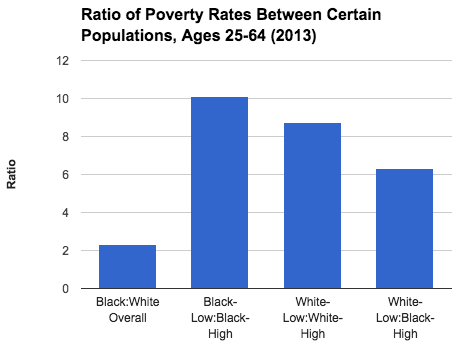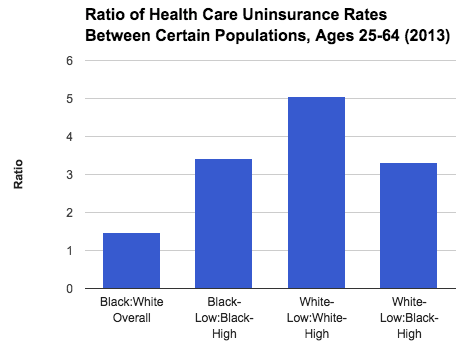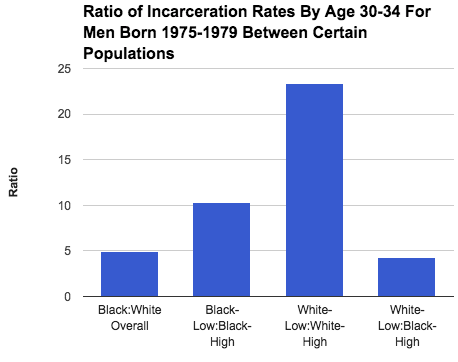In my last post, I broke down five social indicators — poverty, health coverage, employment, incarceration, and life expectancy — by race and class (using educational attainment to stand in for class). The point was to show that, while the disparities across classes are the biggest, there remains significant racial disparities within classes. This suggests race and class both operate in society as drags on well-being.
Multiple commenters have correctly pointed out that the analysis does not make note of the fact that there is a racial disparity in how people are concentrated in each class. A full account of the racial and class effects needs to include that fact as well. I avoided the concentration point in the prior post because this point is normally the one used to suggest that racial disparity is just about class disparity. I wanted to show that racial disparity remains even after you’ve essentially controlled out the racial disparity in who winds up in what class.
Nonetheless, it’s easy enough to present figures that take into account this concentration effect as well. Below, what I do is compare for each indicator:
- The overall black:white disparity. This will reflect both 1) the within-class racial disparity and 2) the racial disparity in class concentration.
- The black-low:black-high disparity. This is the disparity between black less-than-high-school (low) and black college-educated (high).
- The white-low:white-high disparity. Same as (2), but for whites.
- The white-low:black-high disparity. This is the disparity between white less-than-high-school and black college-educated.
1. Poverty
Here is poverty broken down this way.

The first bar says that blacks are, overall, 2.3x as likely as whites to be in poverty. The second bar says blacks in the “lower class” are 10.1x as likely as blacks in the “upper class” to be in poverty. The third bar says whites in the “lower class” are 8.7x as likely as whites in the “upper class” to be in poverty. The fourth bar says whites in the “lower class” are 6.3x as likely as blacks in the “upper class” to be in poverty.
Where the two bars in the middle are higher than the bar on the left, as in this case, that suggests the class effects are bigger than the combined effects of 1) racial disparity within classes and 2) racial disparity in the who winds up in each class. The bar on the right is just kind of interesting to consider.
2. Health Insurance
Here are the same figures for health insurance.

3. Employment
Here are the same figures for employment. Because a higher employment rate is the better outcome in this indicator (unlike the above rates), I have done 1/ratio in order to make the bars visually comparable with the above.

4. Incarceration
Same figures but for incarceration.

Conclusion
So, as you can see, bringing in descriptive stats that reflect the class concentration disparity between races just confirms the basic story in the prior post. In all cases, the within-race class disparity dwarfs the overall racial disparity. Nonetheless, for the reasons explained in the prior post, it would be wrong to say, as some do, that class is the only thing going on here. It does not explain within-class racial disparity and does not explain racial disparity in class concentration, both of which are very significant disparities.